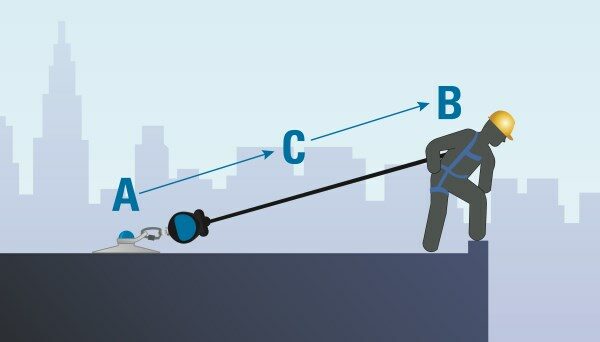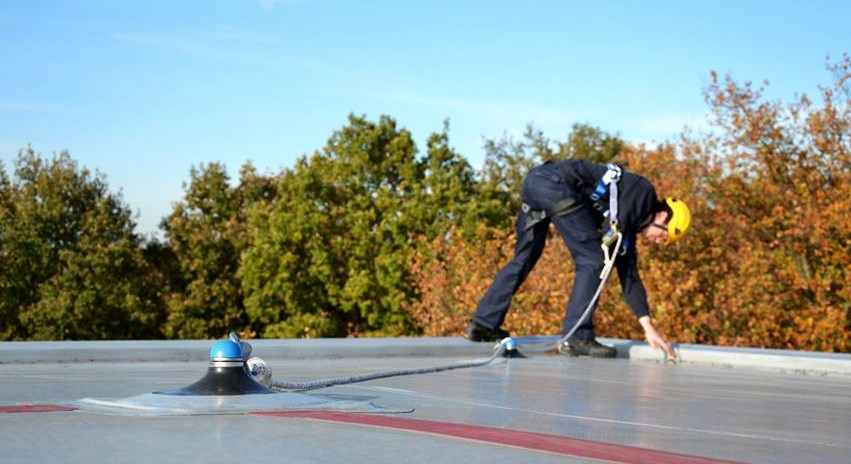In a personal fall protection system, retractable fall arresters and energy absorbing lanyards are both means of Connection (the C in the ABC of Fall Arrest). They connect the A and the B; they connect the user to the anchor point.

The ABC of Fall Arrest
Retractable fall arresters are commonly used with overhead anchorage lines but nowadays, more and more models are suitable for horizontal use too. This means that those models can also be used on roofs, where anchor lines or anchor points are located at the height of the worker’s feet.
So what is the best connecting device for a work restraint system on a roof? In what situations can a retractable fall arrester be used? In this post, we will explain the difference between the various connecting devices.
Work restraint
Readers who know a thing or two about fall protection may know that there are two different ways to use fall protection anchorage on a roof: for work restraint systems or for fall arrest (see: fall arrest or restraint).
From a safety point of view, work restraint should always be preferred over a fall arrest situation because the former is a preventive measure: the length of the connection prevents users from reaching a position from where a fall could occur. This is common practice for work on flat or near-flat roofs.
Lanyard + Rope Grab
When the distance between the anchor point and the work location varies or is more than 2 meters, a different kind of connection is needed. In these situations, the traditional method is to use a long lanyard (rope) with a rope grab and a Personal Energy Absorber (PEA).

Work restraint system where the length of the lanyard connection is set with a rope grab.
A PEA is used to limit the fall arrest shock. Attentive readers will notice something odd here. Why is a PEA needed to absorb the fall arrest shock in a work restraint system that prevents a fall from happening in the first place?
The answer is: because in these situations, the human factor is always a risk.
The risk of misuse
Using a rope with a rope grab requires a user to manually set the length of his connection. Of course, a work restraint system with an adjustable length entails a certain risk of misuse. This risk is covered by a PEA.
So except in situations where fixed-length lanyards are used, there is no physical difference between a rooftop personal fall protection system used for work restraint and one that is used for fall arrest.
In theory, this shouldn’t be a problem because personal fall protection may only be used by trained and qualified workers who know exactly what they’re doing. Still, the system should be capable to arrest their fall if they misuse the system or make a mistake. You never know.
Retractable fall arresters for horizontal work restraint
So a personal fall protection system on a roof needs to provide users the possibility to set a limit for themselves, and to arrest their fall just in case.
Retractable fall arresters come in different lengths, so notwithstanding their name they could just as well be used for work restraint purposes. If the max. length of the cable (or webbing in some cases) is equal or smaller than the distance to the edge, that is. But why would you?
Usability
The main reason to consider using a retractable fall arrester for work restraint purposes, is that a fall arrester ensures a taut connection¹. Users don’t have to adjust the length of their connection: the fall arrester unrolls as they move further away, and retracts as they move back.
¹ This is especially valuable when a flat roof contains fall-through hazards such as skylights. If a fall were to happen, a taut connection ensures a quicker fall arrest.

XStop Retractable Fall Arrest Device

With a rope grab, users are required to perform a manual corrective action every time the rope becomes slack. Users would have to set the length of their connection by adjusting the rope grab which is attached to the back of their harness. Users also have to deal with the excess rope.
Although both solutions offer an equal level of safety (on non-fragile roof surfaces), one could argue that a retractable fall arrester is a more convenient solution.
The downside of a retractable fall arrester however, is that it can only restrain users at its maximum range; it cannot be set to restrain users at intermediate lengths. By contrast, a rope grab can be set at any point on the lanyard.
Conclusion
So, when does one opt for a retractable fall arrester with a permanent fall protection system?
As a building owner with permanent roof anchorage at a fixed distance (more than 2 meters) from the edge, then buying a retractable fall arrester is an excellent way to achieve maximum usability and to make sure that workers cannot misuse the work restraint system: unquestionably a value-add.
However, if the work restraint range on your roof differs, then buying a retractable fall arrester is probably not worth it unless your roof contains a lot of fall-through hazards. A rope grab and lanyard is still a safe and cost-effective solution that can be used in almost any situation.

1 Comment. Leave new
Good Story about a complex Item. Its a Pity that much Owners decide on Price and not choose for the best and safest Solution.
Its a good Thing that Suppliers give such usefull and practical Information.
Pls go on with that!!